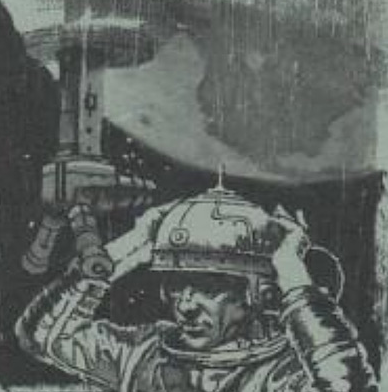Science Fiction
Dictionary
A B C D E F G H I J K L M N O P Q R S T U V W X Y Z
Latest By
Category:
Armor
Artificial
Intelligence
Biology
Clothing
Communication
Computers
Culture
Data Storage
Displays
Engineering
Entertainment
Food
Input Devices
Lifestyle
Living Space
Manufacturing
Material
Media
Medical
Miscellaneous
Robotics
Security
Space Tech
Spacecraft
Surveillance
Transportation
Travel
Vehicle
Virtual
Person
Warfare
Weapon
Work
"The trouble with too much genre SF is that it's so obviously the product of the conscious mind."
- William Gibson
| Solar Yacht Periscope | ||
| A device used in the small cabin of a solar yacht. |
Owing to weight restrictions, the cabin of a solar yacht is very small; specialized viewing optics were needed.
| Diana had made a good start; time to take a look at the opposition. Moving very gently—though there were shock absorbers between the control capsule and the delicate rigging, he was determined to run no risks—Merton stationed himself at the periscope.
 (Periscope of solar yacht) There they were, looking like strange silver flowers planted in the dark fields of space. The nearest, South America’s Santa Maria, was only fifty miles away; it bore a close resemblance to a boy’s kite, but a kite more than a mile on a side. Farther away, the University of Astrograd’s Lebedev looked like a Maltese cross; the sails that formed the four arms could apparently be tilted for steering purposes. In contrast, the Federation of Australasia’s Woomera was a simple parachute, four miles in circumference. General Spacecraft’s Arachne, as its name suggested, looked like a spiderweb, and had been built on the same principles, by robot shuttles spiraling out from a central point. Eurospace Corporation’s Gossamer was an identical design, on a slightly smaller scale. And the Republic of Mars’s Sunbeam was a flat ring, with a half-mile-wide hole in the center, spinning slowly, so that centrifugal force gave it stiffness. That was an old idea, but no one had ever made it work; and Merton was fairly sure that the colonials would be in trouble when they started to turn. That would not be for another six hours, when the yachts had moved along the first quarter of their slow and stately twenty-four-hour orbit. Here at the beginning of the race, they were all heading directly away from the Sun—running, as it were, before the solar wind. One had to make the most of this lap, before the boats swung around to the other side of Earth and then started to head back into the Sun. Time, Merton told himself, for the first check, while he had no navigational worries. With the periscope, he made a careful examination of the sail, concentrating on the points where the rigging was attached to it. The shroud lines—narrow bands of unsilvered plastic film—would have been completely invisible had they not been coated with fluorescent paint. Now they were taut lines of colored light, dwindling away for hundreds of yards toward that gigantic sail. Each had its own electric windlass, not much bigger than a game fisherman’s reel. The little windlasses were continually turning, playing lines in or out as the autopilot kept the sail trimmed at the correct angle to the Sun. |
| Technovelgy from Sunjammer,
by Arthur C. Clarke. Published by Boy's Life in 1963 Additional resources -
|
The periscope had other capabilities:
In sudden understanding, Merton grabbed the periscope, switched to wide-angle vision, and started to scan the edge of the sail. Yes—there was the trouble, and it could have only one cause.
Merton’s first thought was that something had happened to the sail; perhaps the anti-spin devices had failed, and the rigging had become twisted. Swiftly, he checked the meters that showed the tension of the shroud lines. Strange—on one side of the sail they were reading normally, but on the other the pull was dropping slowly, even as he watched.
Comment/Join this discussion ( 0 ) | RSS/XML | Blog This |
Additional
resources:
More Ideas
and Technology from Sunjammer
More Ideas
and Technology by Arthur C. Clarke
Tech news articles related to Sunjammer
Tech news articles related to works by Arthur C. Clarke
| Will Space Stations Have Large Interior Spaces Again? |
| Reflect Orbital Offers 'Sunlight on Demand' And Light Pollution |
| Chrysalis Generation Ship to Alpha Centauri |
| The First Space Warship For Space Force |
Want to Contribute an
Item?
It's easy:
Get the name of the item, a
quote, the book's name and the author's name, and Add
it here.
| <Previous | Next> |
|
|
|
Technovelgy (that's tech-novel-gee!) is devoted to the creative science inventions and ideas of sf authors. Look for the Invention Category that interests you, the Glossary, the Science Fiction Invention Timeline, or see what's New.
|
Science Fiction
Timeline
1600-1899
1900-1939
1940's 1950's
1960's 1970's
1980's 1990's
2000's 2010's
'Power could be compressed thus into an inch-square cube of what looked like blue-white ice'
'It's so light that you can set it up in five minutes by yourself...'
'Heavy penalties... were to be applied to any one found driving manually-controlled machines.'
'Buy a Little Dingbat... electropen, wrist watch, pocketphone, pocket radio, billfold ... all in one.'
'... an elastic, tinted material that had all the feel and appearance of human flesh and epidermis.'
'It is remarkable that the long leverages of their machines are in most cases actuated by a sort of sham musculature...'
